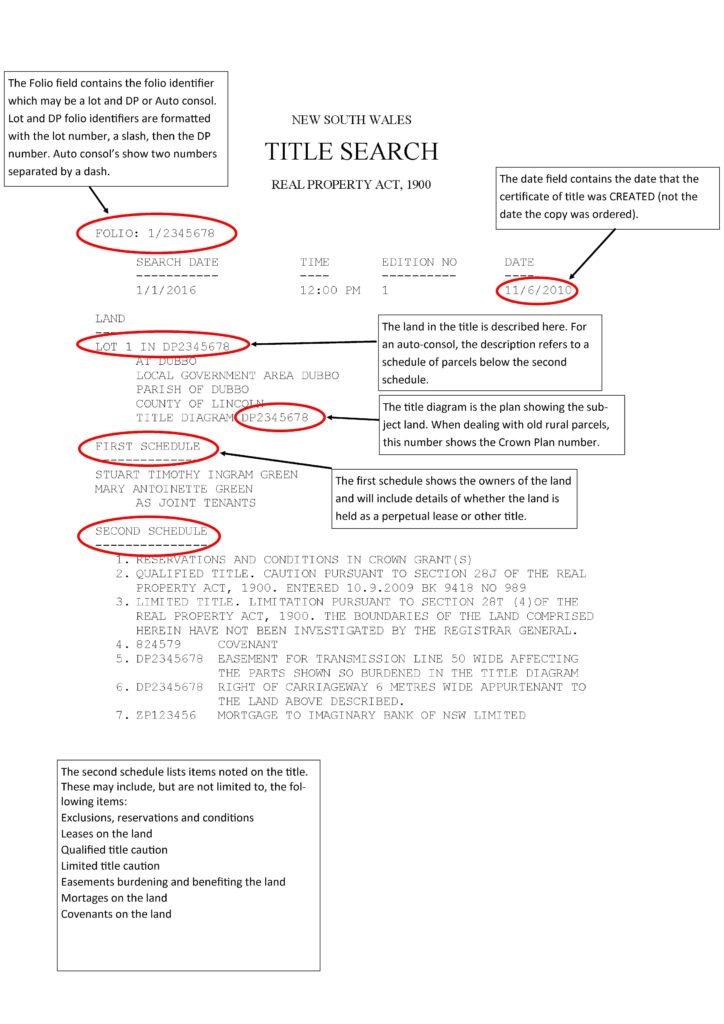Doherty Smith & Associates is now Compass Consulting Surveyors
Click here to see this blog and more on our new website compasscs.com.au
In order to own land in New South Wales, the details of the land and the legal owner are noted on a Register maintained by Land and Property Information NSW. The most secure form of land title is a title issued under the Torrens title system. The Torrens title system is based on a single register for each land holding. The register lists the details of each land parcel, the owner or owners names, registered interests in the title and other information such as the current plan (title diagram) and the date this title was created.
Torrens title for a land parcel is a document guaranteed by the NSW Government. An extract from the register, called a Certificate of Title, is a copy of the information relating to the land parcel. The register has changed over time, from a bound, book-style paper format to what is today a computerised system knows as the Integrated Titling System. The Integrated Titling System, or ITS, lists titles by their folio identifier where the lot and DP is used to generate a unique identifier for each parcel. Folio identifiers are generated from the lot number, section number if applicable, and plan number. Each number is separated by a backslash (/). In this way, the folio identifier for Lot 1 in DP2345678 is 1/2345678. The folio identifier for Lot 2 in section 3 of DP456789 is 2/3/456789.
When dealing with land, a copy of the certificate of title is usually required. Most purchasers of land have seen a copy of the certificate of title included in the contract of sale. A demonstration version of a certificate of title is shown below:
The certificate is arranged with the folio identifier at the top left of the page. The following line details the date and time the title was searched, the edition of the title and the date the current version of the title was created.
Below this is the details of the land, including the lot, plan number, local government area, parish, county and title diagram. This information is useful, particularly when dealing with land with current plans that are not deposited plans. The title diagram is the plan creating the lot in the folio. Older plans are not always given a DP number corresponding to the plan number. In rural areas, all plans in a particular parish will have the same deposited plan number. The only way to determine the plan number is to order a copy of the certificate of title or examine old charting maps.
The First Schedule on a title search shows the owner or owners of the land. If there is more than one owner, the mode of sharing ownership is also shown. Joint tenants own the land together and if one tenant dies, the ownership is passed to the other tenant. Tenants in common have shares in the land, however if one tenant dies their interest in the land is passed on according to their will. The first schedule will also identify whether the land is held as a perpetual lease.
The second schedule on title search shows the registered interests noted on the title. Registered interests on a title may include the following:
- Easements
- Covenants
- Mortgages
- Resumptions
- Caveats
- Subsequent changes in ownership
When a title has a second schedule caution relating to qualified title, the State of NSW does not guarantee the boundary definition or land ownership. Qualified title cautions are placed on titles converted from Old System titles and warns persons dealing with the registered proprietor that the land is held subject to any ‘subsisting interests’ that may exist under Old System.
When a title has a second schedule caution relating to limited title, the State of NSW does not guarantee the boundary definition of the land. When a title is subject to a limited title caution, it is a Certificate of Title issued for land converted from Old System title whereby the boundaries have not been adequately defined in a plan of survey and/or have not been investigated in LPI. A limitation is recorded in the second schedule.
For further information on certificates of title, please see the Land and Property Information NSW fact sheet Torrens Title Information and Search Guide and their website or contact Doherty Smith & Associates.
Eric Smith
Registered Surveyor




